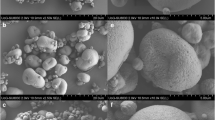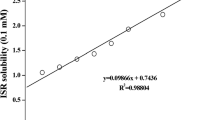Abstract
Ibuprofen-loaded hydrophilic biocompatible polymeric (Eudragit L100) nanoparticles were formulated for the taste masking and solubility enhancement using the spray-drying technique. The various batches of ibuprofen-loaded nanoparticles were prepared by varying the mass ratios of methacrylate copolymer (Eudragit L100), PVP K30, and β-cyclodextrin. The different characteristics of the recovered nanoparticles were evaluated by field emission scanning electron microscopy (FESEM), particle size analysis, X-ray diffraction (XRD), and Fourier transform infrared spectroscopy (FTIR) as well as taste-masking ability and phase solubility. The nanoparticles prepared using the mixture showed a decrease in crystallinity, narrow particle size distribution, and increased solubility as compared to those prepared using pure ibuprofen under similar operating conditions. FESEM results revealed that the nanoparticles are smooth, spherical, and of nearly uniform size. The taste evaluations of the encapsulated nanoparticles were carried out using an in vitro method by measuring the drug release rate.









Similar content being viewed by others
References
Zhou, J., Horev, B., Hwang, G., Klein, M. I., Koo, H., & Benoit, D. S. W. (2016). Characterization and optimization of pH-responsive polymer nanoparticles for drug delivery to oral biofilms. Journal of Materials Chemistry B, 4(18), 3075–3085.
Braig, V., Konnerth, C., Peukert, W., & Lee, G. (2019). Enhanced dissolution of naproxen from pure-drug, crystalline nanoparticles: a case study formulated into spray-dried granules and compressed tablets. International Journal of Pharmaceutics, 554, 54–60.
Jansook, P., Ogawa, N., & Loftsson, T. (2018). Cyclodextrins: structure, physicochemical properties and pharmaceutical applications. International Journal of Pharmaceutics, 535(1–2), 272–284.
Shelley, H., & Babu, R. J. (2018). Role of cyclodextrins in nanoparticle-based drug delivery systems. Journal of Pharmaceutical Sciences, 107(7), 1741–1753.
Shan-Yang, L., & Yuh-Horng, K. (1989). Solid particulates of drug-β-cyclodextrin inclusion complexes directly prepared by a spray-drying technique. International Journal of Pharmaceutics, 56(3), 249–259.
Van Den Hoven, J. M., Metselaar, J. M., Storm, G., Beijnen, J. H., & Nuijen, B. (2012). Cyclodextrin as membrane protectant in spray-drying and freeze-drying of PEGylated liposomes. International Journal of Pharmaceutics, 438(1–2), 209–216.
Patel, A. R., & Vavia, P. R. (2008). Preparation and evaluation of taste masked famotidine formulation using drug/β-cyclodextrin/polymer ternary complexation approach. AAPS PharmSciTech, 9(2), 544–550.
Deshmukh, R., Wagh, P., & Naik, J. (2016). Solvent evaporation and spray drying technique for micro- and nanospheres/particles preparation: a review. Drying Technology, 34(15), 1758–1772.
Naik, J. B., & Deshmukh, R. K. (2016). Optimization of spray-dried diclofenac sodium-loaded microspheres by screening design. Drying Technology, 34(13), 1593–1603.
Mokale, V., Rajput, R., Patil, J., Yadava, S., & Naik, J. (2016). Formulation of metformin hydrochloride nanoparticles by using spray drying technique and in vitro evaluation of sustained release with 32-level factorial design approach. Drying Technology, 34(12), 1455–1461.
Patil, J., Rajput, R., Nemade, R., & Naik, J. (2018). Preparation and characterization of artemether loaded solid lipid nanoparticles: a 32 factorial design approach. Materials and Technologies. https://doi.org/10.1080/10667857.2018.1475142.
Waghulde, M., Rajput, R., Mujumdar, A., & Naik, J. (2018). Production and evaluation of vildagliptin-loaded poly (dl-lactide) and poly (dl-lactide-glycolide) micro−/nanoparticles: response surface methodology approach. Drying Technology, 37(10), 1265–1276.
Koczkur, K. M., Mourdikoudis, S., Polavarapu, L., & Skrabalak, S. E. (2015). Polyvinylpyrrolidone (PVP) in nanoparticle synthesis. Dalton Transactions, 44(41), 17883–17905.
Thybo, P., Pedersen, B. L., Hovgaard, L., Holm, R., & Müllertz, A. (2008). Characterization and physical stability of spray dried solid dispersions of probucol and PVP-K30. Pharmaceutical Development and Technology, 13(5), 375–386.
Xu, B., Zhang, W., Chen, Y., Xu, Y., Wang, B., & Zong, L. (2018). Eudragit® L100-coated mannosylated chitosan nanoparticles for oral protein vaccine delivery. International Journal of Biological Macromolecules, 113, 534–542.
Shen, X., Yu, D., Zhu, L., Branford-White, C., White, K., & Chatterton, N. P. (2011). Electrospun diclofenac sodium loaded Eudragit® L 100-55 nanofibers for colon-targeted drug delivery. International Journal of Pharmaceutics, 408(1–2), 200–207.
Verma, U., Rajput, R., & Naik, J. B. (2018). Development and characterization of fast dissolving film of chitosan embedded famotidine using 32 full factorial design approach. Materials Today: Proceedings, 5(1), 408–414.
Patil, J., Rajput, R., Patil, P., Mujumdar, A., & Naik, J. (2020). Generation of sustained release chitosan nanoparticles for delivery of ketorolac tromethamine: a tubular microreactor approach. International Journal of Polymeric Materials and Polymeric Biomaterials, 69(8), 516–524.
Verma, U., Mujumdar, A., & Naik, J. (2020). Preparation of efavirenz resinate by spray drying using response surface methodology and its physicochemical characterization for taste masking. Drying Technology, 38(5–6), 793–805.
Irvine, J., Afrose, A., & IslamN. (2018). Formulation and delivery strategies of ibuprofen: challenges and opportunities. Drug Development and Industrial Pharmacy, 44(2), 173–183.
Puccetti, M., Giovagnoli, S., Zelante, T., Romani, L., & Ricci, M. (2018). Development of novel Indole-3-aldehyde–loaded gastro-resistant spray-dried microparticles for postbiotic small intestine local delivery. Journal of Pharmaceutical Sciences, 107(9), 2341–2353.
Hou, Y., Shao, J., Fu, Q., Li, J., Sun, J., & He, Z. (2017). Spray-dried nanocrystals for a highly hydrophobic drug: increased drug loading, enhanced redispersity, and improved oral bioavailability. International Journal of Pharmaceutics, 516(1–2), 372–379.
Verma, U., Naik, J. B., Patil, J. S., & Yadava, S. K. (2017). Screening of process variables to enhance the solubility of famotidine with 2-hydroxypropyl–β-cyclodextrin & PVP K-30 by using Plackett–Burman design approach. Materials Science and Engineering: C, 77, 282–292.
Popat, A., Liu, J., Lu, G. Q., & Qiao, S. Z. (2012). A pH-responsive drug delivery system based on chitosan coated mesoporous silica nanoparticles. Journal of Materials Chemistry, 22(22), 11173–11178.
Lokhande, A. B., Mishra, S., Kulkarni, R. D., & Naik, J. B. (2013). Preparation and characterization of repaglinide loaded ethylcellulose nanoparticles by solvent diffusion technique using high pressure homogenizer. Journal of Pharmacy Research, 7(5), 421–426.
Khairnar, G., Pritam, P., Vinod, M., & Jitendra, N. (2015). Investigation on the development of losartan potassium sustained release microspheres by solvent evaporation methods. Micro and Nanosystems, 7(3), 190–196.
Rameshwar, D., Arun, M., & Jitendra, N. (2017). Production of aceclofenac-loaded sustained release micro/microparticles using pressure homogenization and spray drying. Drying Technology, 36(4), 459–467.
Waghulde Mrunal, R., & Naik, J. B. (2016). Poly-e-caprolactone-loaded miglitol microspheres for the treatment of type-2 diabetes mellitus using the response surface methodology. Journal of Taibah University Medical Sciences, 11(4), 364–373.
Kharb, V., Saharan, V. A., Jadhav, H., & Purohit, S. (2014). Formulation and evaluation of lipid-based taste masked granules of ondansetron HCl. European Journal of Pharmaceutical Sciences, 62, 180–188.
Guhmann, M., Preis, M., Gerber, F., Pöllinger, N., Breitkreutz, J., & Weitschies, W. (2015). Design, development and in-vitro evaluation of diclofenac taste-masked orodispersible tablet formulations. Drug Development and Industrial Pharmacy, 41(4), 540–551.
Dora, C. P., Trotta, F., Kushwah, V., Devasari, N., Singh, C., Suresh, S., & Jain, S. (2017). Potential of erlotinib cyclodextrin nanosponge complex to enhance solubility, dissolution rate, in vitro cytotoxicity and oral bioavailability. Carbohydrate Polymers, 339–349.
Schönbeck, C., Madsen, T. L., Peters, G. H., Holm, R., & Loftsson, T. (2017). Soluble 1: 1 complex and insoluble 3: 2 complexes–understanding the phase-solubility diagram of hydrocortisone and γ-cyclodextrin. International Journal of Pharmaceutics, 531(2), 504–511.
Dugar, R. P., Gajera, B. Y., & Dave, R. H. (2016). Fusion method for solubility and dissolution rate enhancement of ibuprofen using block copolymer poloxamer 407. AAPS Pharm SciTech., 17(6), 1428–1440.
Verma, U., Naik, J. B., Deshmukh, R., & Mishra, S. (2018). Development of biodegradable glimepiride loaded chitosan Nano particles: a factorial design approach. Current Environment Engineering, 5(1), 68–77.
Mantas, A., Labbe, V., Loryan, I., & Mihranyan, A. (2019). Amorphisation of free acid ibuprofen and other profens in mixtures with nanocellulose: dry powder formulation strategy for enhanced solubility. Pharmaceutics, 11(2), E68.
Waghulde, M., Rajput, R., Mujumdar, A., & Naik, J. (2019). Production and evaluation of vildagliptin-loaded poly (dl-lactide) and poly (dl-lactide-glycolide) micro−/nanoparticles: response surface methodology approach. Drying Technology, 37(10), 1265–1276.
Parmar, C., Parikh, K., Mundada, P., Bhavsar, D., & Sawant, K. (2018). Formulation and optimization of enteric coated bilayer tablets of mesalamine by RSM: In vitro – in vivo investigations and roentogenographic study. Journal of Drug Delivery Science and Technology, 44, 388–398.
Ferdousy, S., Sajeeb, B., Yeasmin, S., & Faroque, A. (2018). Impact assessment of different polymers on physicochemical properties of ibuprofen loaded solid dispersions. Dhaka University Journal of Pharmaceutical Sciences, 17(2), 183–190.
Hassani, N. A., Abdouss, M., & Faghihi, S. (2014). Synthesis and evaluation of PEG-O-chitosan nanoparticles for delivery of poor water-soluble drugs: ibuprofen. Materials Science and Engineering: C, 41, 91–99.
Kamarudin, N. H. N., Jalil, A. A., Triwahyono, S., Artika, V., Salleh, N. F. M., Karim, A. H., Jaafar, N. F., Sazegar, M. R., Mukti, R. R., Hameed, B. H., & Johari, A. (2014). Variation of the crystal growth of mesoporous silica nanoparticles and the evaluation to ibuprofen loading and release. Journal of Colloid and Interface Science, 421, 6–13.
Dian, L., Yang, Z., Li, F., Wang, Z., Pan, X., Peng, X., Huang, X., Guo, Z., Quan, G., Shi, X., Chen, B., Li, G., & Wu, C. (2013). Cubic phase nanoparticles for sustained release of ibuprofen: formulation, characterization, and enhanced bioavailability study. International Journal of Nanomedicine, 8, 845–854.
Bhawana, R., Basniwal, K., Buttar, H. S., Jain, V. K., & Jain, N. (2011). Curcumin nanoparticles: preparation, characterization, and antimicrobial study. Journal of Agricultural and Food Chemistry, 59(5), 2056–2061.
Karathanos, V. T., Mourtzinos, I., Yannakopoulou, K., & Andrikopoulos, N. K. (2007). Study of the solubility, antioxidant activity and structure of inclusion complex of vanillin with β-cyclodextrin. Food Chemistry, 101(2), 652–658.
Acknowledgments
The authors gratefully acknowledge SP pharmaceuticals, Jalgaon, India, for providing a gift sample of ibuprofen.
Funding Statement
The work was supported by University Grants Commission, New Delhi (F. No. 43-159/2014(SR)).
Author information
Authors and Affiliations
Corresponding author
Ethics declarations
Conflict of the Interest
The authors declare that they have no conflict of interest.
Research Involving Humans and Animals Statement
This article does not contain any studies with human participants or animals perform by any of the authors.
Informed Consent
None.
Additional information
Publisher’s Note
Springer Nature remains neutral with regard to jurisdictional claims in published maps and institutional affiliations.
Rights and permissions
About this article
Cite this article
Naik, J., Rajput, R. & Singh, M. Development and Evaluation of Ibuprofen Loaded Hydrophilic Biocompatible Polymeric Nanoparticles for the Taste Masking and Solubility Enhancement. BioNanoSci. 11, 21–31 (2021). https://doi.org/10.1007/s12668-020-00798-y
Accepted:
Published:
Issue Date:
DOI: https://doi.org/10.1007/s12668-020-00798-y




